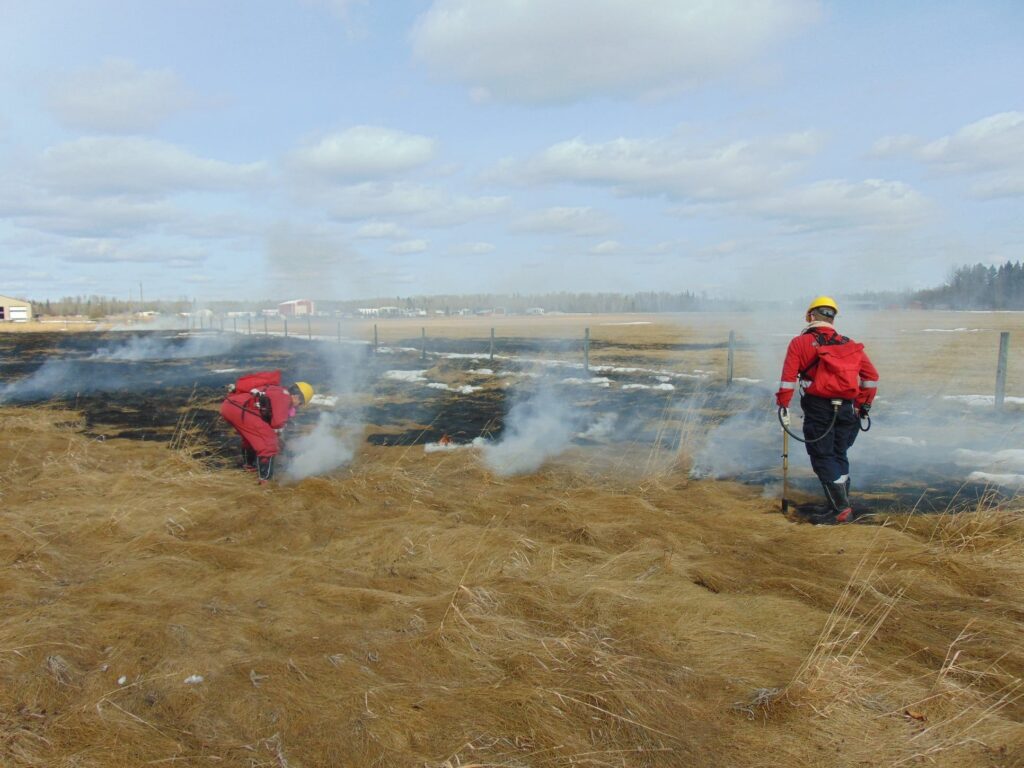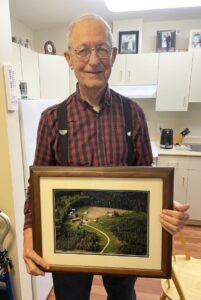
The Whitecourt Fire Department trucks screamed out to the first grass fire of the season on March 30. The two-acre blaze, the result of a burn barrel on a windy day, didn’t grow as big as it could’ve thanks to a nearby plot of land that stopped the fire in its tracks. “There was a field with tall grass that burned, but there was a crop next door that was baled and removed. With that fuel removed and only short grass left behind, the fire burned itself out,” explained Whitecourt Fire Chief Brian Wynn. “If there’s no fuel, then there’s no fire.”
He said that typically residents see problematic areas on their property with fuels, such as grass and leaves, in the spring when the dry, brown foliage appears from beneath the disappearing snow. “In the fall, you don’t see it as much because it’s green, but in the spring, you see it.” Chief Wynn said that the best way to deal with these types of fine fuels is to take care of them in the fall before it becomes an issue six months later. “If you went for a walk or you looked around your yard, I’m sure you could see areas that need work. Take a picture and put it on your calendar for the fall to remind you to deal with it,” he suggested.
The biggest issue with the tall grass in the spring is that any spark can light it up, and since it is so dry, it can spread very rapidly. “It becomes tinder dry, and it doesn’t take much to get it going, especially with a little wind.” The burn barrel that started the recent fire could have been much worse. “People with burning barrels have to be extremely careful with the embers that are flying out of the garbage. Make sure you have your screen on top of it to try and hold in most of the embers, and obviously, windy days are not the day to be burning anything,” explained Chief Wynn.
He reminds residents to get burning permits, now back in effect through Alberta Forestry, before making any plans. “They will come out to the site and inspect it and give you information.” The risk of burning without a permit or burning when permits are pulled due to conditions could be costly. “Anybody that starts a wildfire could be charged the cost of putting out of the wildfire. If Alberta Forestry brings in helicopters and waterbombers, you can be liable for the full cost of putting it out. That could add up to be tens of thousands of dollars rather quickly. I think one water bomber drop costs $50,000, so it doesn’t take long to get a huge bill.”
Chief Wynn said that if someone started a fire by accident, after following rules and guidelines, the results likely wouldn’t be the same. “Getting a permit and having Alberta Forestry come out provides you with education because they look at your property and have that discussion on when and where it is safe to burn. If the conditions are bad, or permits are pulled back due to a high hazard, and you go ahead and burn and cause a fire, then I’m pretty sure you’re going to be liable. Whereas if you’re following the guidelines, then I’m sure it’s going to be an easier conversation to have with them.”
Down near Lethbridge, a grass fire caused evacuations of nearby county residents. “The fire took out some structures and put a community on alert for evacuation, and that’s just for a grass fire, but when you get the wind-driven fires, you can’t keep up to them because they are moving so fast,” he explained.
Like the one outside of Whitecourt, even a small grass fire commands lots of work to put out. “We had 11 people out fighting it, and Alberta Forestry came out afterward with three people. Alberta Forestry is not even manned up yet. They delayed bringing on crews because of budget purposes, so right now, the crews are not even hired on yet.” Chief Wynn said that the provincial government had delayed bringing on the fire crews to save budget dollars. “But that has nothing to do with the fire hazard and doesn’t lower the risk.”
As spring continues, he said they would be keeping watch on the moisture level. “The rain will start to green things up a lot quicker. The frost isn’t out of the ground yet, but the fuels are still there.” He added that the low snow cover this past winter is a problem, but luckily, there is a high water table leftover from the fall. “The water is in the ground, and that’s a good thing. If it weren’t, then we would have a lot higher hazard.”
Chief Wynn does not recommend trying to mow down the dry grasses since hitting a rock could cause a spark and ignite it. “Instead, you could rake and try and remove some of the fine fuels and move them away from your structures. Not just your house but also your barns or any other outside buildings. That way, if something does ignite, all you will have to do is remove the fuel, and the fire will not burn.”
For residents in Woodlands County, the most straightforward fix could be getting an animal to munch down the fuels. The property where the fire had taken place, the owners, had purchased three llamas in the winter, but it was too late in the year for them to eat much of the grasses. “A few animals or a horse or cow can mitigate most of those tall grasses if they can eat on them year-round. I was out at a residence last year that had one calf that they kept in the fenced-in area around their property, and it mitigated all the tall grasses just by eating it. There is not a lot of work or effort for that. All you need is for the area to be fenced, and the animal will look after it,” explained Chief Wynn. Educating residents on FireSmart will be a continuing theme through the warmer months with informative articles, social media engagement, home assessments, and activity in the public eye, such as through the summer FireSmart crew.







More Stories
Reminiscing with Residents: Spruceview edition with Jurgen Moll
A great ending to the regular season, with the post-season coming up next
The Wolverines are on fire as the countdown to the playoffs is on